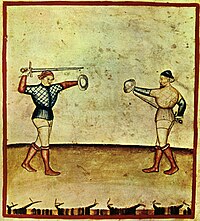Buckler



A buckler (French bouclier 'shield', from Old French bocle, boucle 'boss') is a small shield, 15 to 45 cm (6 in to 18 in) in diameter,[citation needed] gripped in the fist. It was generally used as a companion weapon in hand-to-hand combat during the Medieval and Renaissance periods. Its size made it poor protection against missile weapons (e.g., arrows) but useful in deflecting the blow of an opponent's sword or mace. There are two major forms of medievally documented bucklers. The first is a simple round shield with the fist positioned directly behind the boss with a variety of shapes of face and depths of rim. These could also have projections from the top and bottom as in Hans Talhoffer's Fechtbücher or serrated rings around the boss as in one example in the Wallace Collection. The second major form is a corrugated rectangle as suggested by Achille Marozzo in his Opera Nova.
MS I.33, considered the earliest extant armed-combat manual, (around 1300) contains an early description of a system of combat with buckler and sword.
Uses
The buckler was more widely used than is commonly known. It was a simple yet effective weapon, often combined with a short sword, falchion, or rapier. It was popular circa 1100 to 1600.[1] The buckler had a variety of roles when it came to swordplay, but five principal means come to the fore as described in MS I.33. Each use recognizes the shield's small size and maneuverability when dealing with light blades.
- Hand protection: The primary use of the buckler was to protect the sword hand.
- Deflector: The buckler's lightness and curved center made it excellent for deflecting attacking blades.
- Blinder: The light blades used in conjunction with the buckler depended on rapid movements, which meant that a single second was an important advantage. The wielder of the buckler could use the buckler to shield his sword-hand's position from view, keeping his opponent from guessing his next strike.
- "Metal fist": A buckler could be used to directly attack an opponent by punching with either its flat face or its rim.
- Binder: The buckler could be used to bind an opponent's sword hand and weapon as well as their buckler against their body. The buckler was also very useful in grappling, where it allowed an opponent's arms to be easily wrapped up and controlled.
Decoration
In classical antiquity, bucklers on medals were either used to signify public vows rendered to the gods for the safety of a prince, or that he was esteemed the defender and protector of his people: these were called votive bucklers, and were hung at altars, etc.[2]
See also
- Adarga
- Lantern shield
- Rodeleros (lit., "shield bearers", also known as "sword and buckler men")
- Swashbuckler
- Targe
References
- ^ http://www.thearma.org/essays/SwordandBuckler.htm The Sword & Buckler Tradition
- ^
 This article incorporates text from a publication now in the public domain: Chambers, Ephraim, ed. (1728). Cyclopædia, or an Universal Dictionary of Arts and Sciences (1st ed.). James and John Knapton, et al.
This article incorporates text from a publication now in the public domain: Chambers, Ephraim, ed. (1728). Cyclopædia, or an Universal Dictionary of Arts and Sciences (1st ed.). James and John Knapton, et al. {{cite encyclopedia}}: Missing or empty|title=(help)
External links
| External images | |
|---|---|
